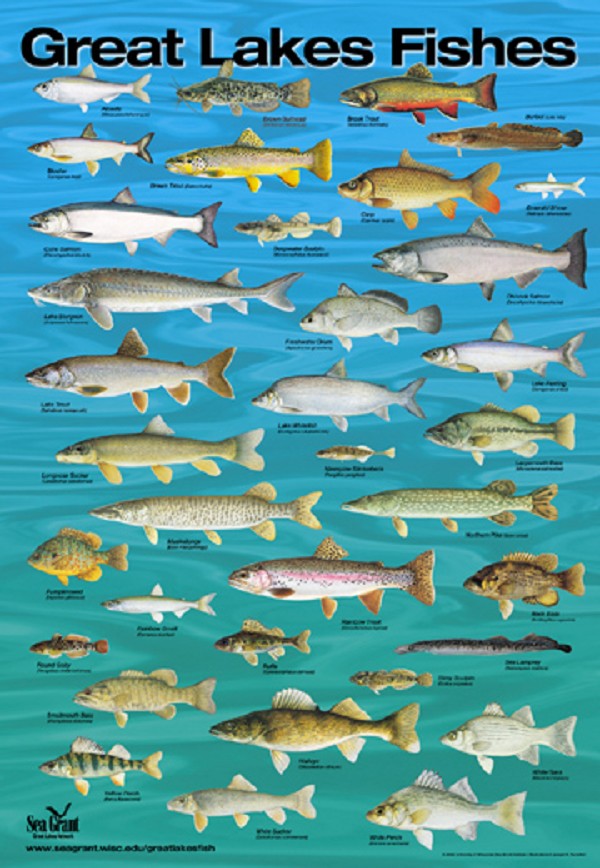
Fishing in the Great Lakes is better than ever. HOW THEY BITIN'? Fishing Good in the Great Lakes, New State Report Says
|
||||||||||
| Printer Friendly Story View |
Despite the depredations of 39 invasive species, fishing in the Great Lakes is better than ever -- and improving even more.
This year in Michigan, Great Lakes anglers spent 4.3 million hours in pursuit of the "big one" or in many cases, dinner.
Catch rates for Saginaw Bay walleye have skyrocketed since 2004, peaking in 2008 at a 30-year high. That year, catch rates for walleye were seven times those seen in the 1980s and 90s.
Likewise, climbing catch rates in Lake Huron's steelhead fishery over the last several years show improvement and promise for the future.
Fishing is a huge contributor to quality of life in Michigan, for those who live here and for the state's many visitors, according to a recent state report "The State of the Great Lakes 2012."
The report's section on Great Lakes Fisheries was the product of Todd Grischke, Todd Kalish and Phillip Schneeberger, Michigan Department of Natural Resources Basin Coordinators for Lakes Huron, Michigan/Erie and Superior.
"The successes seen in Great Lakes fisheries result largely from a combination of investments in critical habitat protection, quality hatchery products and efforts to rehabilitate native species," according to the authors.
Strong wild reproduction of salmon, steelhead, walleye and perch has added to this success.
On the other side of the coin, the lakes have also seen negative impacts from aquatic invasive species such as sea lamprey, zebra mussels, quagga mussels, alewives and round gobies.
For example, the Lake Huron food web has changed dramatically during the past decade, from the plankton at the base to the Chinook salmon at the top.
The lake's most productive zones, historically offshore, have shifted toward nearshore areas as a result of these changes, with an effect on which fish species dominate the lake.
Alewives, once the main prey fish in Lake Huron, have fallen to an alltime low. Chinook salmon, reliant on alewives for food, have also declined.
The DNR has implemented significant stocking reductions of Chinook salmon in Lakes Huron and Michigan to match the declining levels of productivity in the lakes, with natural reproduction the primary contributor to the fishery.
The decline of alewives also correlates with lakewide increases in wild reproduction of lake trout -- a potential sign of a recovering population.
Other Lake Huron fish like walleye, yellow perch and smallmouth bass have also shown signs of significant natural reproduction in the past decade.
In an effort to protect these fisheries, recent, focused control efforts have helped to keep sea lamprey populations below historic levels, but they are still above the target identified for effective control in Lake Michigan and Lake Huron.
Non-native smelt have declined, but distribution of the invasive round goby continues to grow. In Lake Superior, at least 39 invasive species have become established over the past four decades. In spite of these challenges, the lake boasts completely rehabilitated populations of lake trout, which reached perilous lows in the 1950s, 60s and 70s. Today the fish have achieved near-historic levels of abundance in most areas of the lake due to stocking, and are now self-sustaining.
Lake Erie presents a very different fishery than the upper Great Lakes, characterized by perch and walleye. Yellow perch populations have fluctuated, drastically falling and rising twice since the 1960s due to nutrient problems in the lake, the varying health of plant life called macrophytes, overexploitation and other issues. Interagency efforts to reduce exploitation and protect spawning perch have resulted in the rebuilding of stocks, steady harvest and several recent strong year-classes.
In 2005, Lake Erie's overall walleye population surged, becoming a "high quality" stock, indicating more than 40 million individuals, for the first time since 1993. Improved management and reproductive success, as well as a higher availability of food led to this increase.
The population has fluctuated since 2005 but some postulate that the potential for trophy walleye in Lake Erie has never been higher.
The report concludes: "Michigan's world-class freshwater fishery depends on healthy lakes and careful understanding of these complex ecosystems. The state's $2 billion annual angling economy supports thousands of people and raises quality of life for residents and visitors alike. Great fishing is just one part of Pure Michigan, but it is an essential part."
###
| Printer Friendly Story View |
|
|

Dave Rogers |
|
|
|
Printer-Friendly Story View
0200 Nd: 04-21-2024 d 4 cpr 0
12/31/2020 P3v3-0200-Ad.cfm
SPONSORED LINKS
12/31/2020 drop ads P3v3-0200-Ad.cfm


